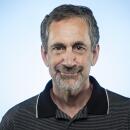Giving a Picture a Second Look
- Share via
A double exposure can mean a lot of things, and most of them are bad. But photographer Jerry N. Uelsmann has a different twist to the normally feared double exposure. In fact, he believes the more exposures the better.
“Getting it all lined up is a real challenge,” Uelsmann said. “The most that I’ve done on any print is seven. The average is three or four.”
His untitled photograph of floating leaves over an ornate couch illustrates the artistic vision and technique that makes Uelsmann’s work different. The image uses five negatives: the couch, the leaves, shadows, a tree and the sky.
“I now have a tremendous freedom when I photograph,” he said. “The camera gives me a license to explore. I go out and collect things with my camera. I don’t have to complete the image each time I go out and shoot. The real creative and most challenging part for me is when I sit down later with the contact sheet and reconstruct the image.”
Initially, he produces a very limited number of prints. It usually takes the greater part of a day just to set up one photograph. He must test each exposure to try to get the various elements to blend together. Each negative sits in a different enlarger, and the paper is moved from one enlarger to another. This is where the exposure and dodging must also be worked out.
“Once I get to that point, I try to make at least six prints,” Uelsmann said. “It’s impossible to predict how many I will need. There is just a small selection of photographs, probably 20, that sell the most. I have gone back and reprinted those, but most are very limited editions.”
His images come from all over the country, including Yosemite, where he worked with Ansel Adams. Another favorite location is the Gulf Coast of Florida.
Uelsmann became interested in photography when he was growing up in Detroit. “My dad had always been interested in photography so there was always a 4-by-5 camera around the house,” he said. “At one point it kind of kicked in. I remember having to accompany him to the camera store and I was bored stiff. Then one summer I was out of school and used the camera and found it to be intriguing.”
During high school, he helped a professional photographer shoot weddings and eventually saved enough money to attend Rochester Institute of Technology in New York.
It was at RIT and later Indiana University that he sought to answer all his questions about photography.
“A part of me was trying to replicate the history of American photography in the late ‘50s,” Uelsmann said. “I was very sensitive and open to a lot of different photographers’ work. I had a variety of approaches.”
He was trying a variety of approaches and put more energy toward the experimental side. He learned in a class on 19th-Century art that artists did not accept what was given to the eye, but felt they could invent a reality that was personally more meaningful. And that’s what he set out to do in his own work.
“It was in retrospect that I realized that a lot of seeds were planted then to permit me to begin to engage in photography the way I now do it,” he said.
“In reality it was complex. Part of me was very involved in documentary photography such as a slum district I would photograph. At the same time, I would come upon images that were abstract. I would make images that were visual concerns, and then there were some that were more factual, probing and thoughtful. The pictures were becoming less and less decorative and much more challenging to people.
“In the early ‘60s, people were telling me, ‘What you’re doing is interesting, but it’s not photography.’ It always bothered me.”
Currently, Uelsmann, 54, is a graduate research professor at the University of Florida and lives in Gainesville. His most current work will be on display at the Susan Spiritus Gallery at South Coast Plaza’s Crystal Court in Costa Mesa until March 5.
The Photography Column, which runs Saturdays in Orange County Life, is intended to help the serious amateur and weekend shooter. Questions and ideas are encouraged. Write to: Robert Lachman, Chief Photographer, The Times, 1375 Sunflower Ave., Costa Mesa, Calif. 92626.
More to Read
Sign up for The Wild
We’ll help you find the best places to hike, bike and run, as well as the perfect silent spots for meditation and yoga.
You may occasionally receive promotional content from the Los Angeles Times.







